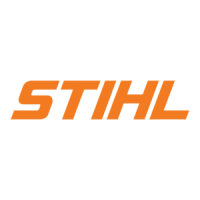0478 403 9802 B - EN
38
● Secure the tiller on the load floor using
ropes or straps to prevent it from
slipping.
Lashing points:
Transport chassis axle (3) and hoe
axle (4).
The machine, its packaging and
accessories are all produced
from recyclable materials and
must be disposed of
accordingly.
By disposing of materials separately and in
an environmentally-friendly manner,
valuable resources can be re-used. For
this reason, the machine should be
disposed of for recycling at the end of its
useful life.
14.1 Disposal
Waste products such as used oil (engine
oil, gearbox oil) and fuel must always be
disposed of properly.
Render the engine unusable prior to
disposal. In particular, remove the ignition
lead, empty the fuel tank and drain the
engine oil.
Risk of injury from the hoes!
Always store an old tiller in a safe place
prior to scrapping. Make sure that the
machine and the hoes are kept out of the
reach of children.
Important information on maintenance
and care of the product group
petrol tillers (STIHL MH)
STIHL assumes no liability for material or
personal damage caused by the non-
observance of information contained in the
operating instructions, in particular with
regard to safety, operation and
maintenance, or which arise through the
use of unauthorised attachment or spare
parts.
Please always observe the following
important information for the prevention of
damage or excessive wear to your STIHL
machine:
1. Wearing parts
Some parts of the STIHL machine are
subject to normal wear even when used
properly and must be replaced in due time
depending on type and duration of use.
These include:
– V-belt
–Hoe
– Brake spur
2. Compliance with the information in
this instruction manual
The STIHL machine must be used,
maintained and stored with the care
described in this instruction manual. Any
damage caused by non-compliance with
the safety, operating and maintenance
instructions is the sole responsibility of the
user.
This applies in particular to:
– Improper use of the product.
– Use of fuel and lubricants not approved
by STIHL (lubricants, petrol and engine
oil, see engine instruction manual).
– Product modifications not approved by
STIHL.
– The use of attaching parts, attachments
or cutting tools not approved by STIHL.
– Use of the product for sporting or
competitive events.
– Resultant damage due to continued use
of the product with defective
components.
3. Maintenance operations
All operations listed in the section
"Maintenance" must be performed
regularly.
If these maintenance operations cannot be
carried out by the user, a specialist dealer
must be commissioned to perform them.
STIHL recommends that you have
maintenance operations and repairs
performed exclusively by a STIHL
specialist dealer.
STIHL specialist dealers regularly attend
training courses and are provided with
technical information.
If these operations are neglected, faults
may arise which are the responsibility of
the user.
These include:
– Corrosive and other resultant damage
caused by incorrect storage.
– Damage to the machine through the
use of inferior-quality spare parts.
14. Environmental protection
15. Minimising wear and
preventing damage

